
San Pietro, or St Peter, is the Neoclassical-style, main Roman Catholic church or duomo of the town of Schio, region of Veneto, Italy.

San Pietro, or St Peter, is the Neoclassical-style, main Roman Catholic church or duomo of the town of Schio, region of Veneto, Italy.

A chapel at the site was present since medieval times, becoming a church by the 12th-century dependent on the church of Pievebelvicino (Torrebelvicino), which was the mother church of the Val Leogra. With the rising importance of Schio, this became the home of the archpriest for the region and principal church. The nave was built between 1740 and 1754 by Giovanni Battista Miazzi, with refurbishment of the choir in 1780 by Domenico Cerato. A new church facade was erected between 1805 and 1820, using designs of Antonio Diedo, carried out by Carlo Barrera. The scenographic staircases leading to the raised balcony-platform in front of the facade were erected in 1837 by Tommaso Meduna. The facade has a sober pronaos and flanked by symmetric bell-towers, inspired by the Palladian designs of a chapel (Tempietto Barbaro) at Villa Barbaro in Maser. The adjacent canon's house or manse, with a clock on the facade, and the lateral aisles of the church were added between 1877 and 1879 by Alessandro Rossi.
Inside the altars date to the 18th-century. The interior decoration is by various artists, including Valentino Zajec (bas-reliefs in nave, and statues of the evangelists and apostles); Giovanni Busato (monochrome frescoes in apse and the altarpiece depicting Saints Carlo and Luigi; Valentino Pupin (ceiling fresco and the altarpiece depicting St Joseph; Romano and Guido Cremasco; Tito Chini (apse and window spandrel decorations), and Alfredo Ortelli (Jesus the teacher). The sacristy has canvases by Alessandro Maganza and Tomaso Pasquotti. The church has two organs, one by Mascioni del 1942 and an 18th-century organ from Puglia. [1]
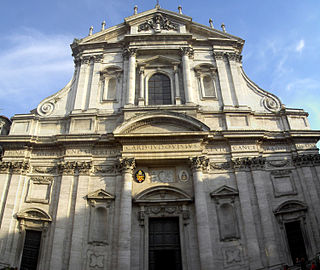
The Church of St. Ignatius of Loyola at Campus Martius is a Roman Catholic titular church, of deaconry rank, dedicated to Ignatius of Loyola, the founder of the Society of Jesus, located in Rome, Italy. Built in Baroque style between 1626 and 1650, the church functioned originally as the chapel of the adjacent Roman College, which moved in 1584 to a new larger building and was renamed the Pontifical Gregorian University.
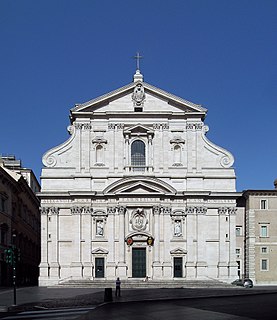
The Church of the Gesù is the mother church of the Society of Jesus (Jesuits), a Catholic religious order. Officially named Chiesa del Santissimo Nome di Gesù all'Argentina, its facade is "the first truly baroque façade", introducing the baroque style into architecture. The church served as a model for innumerable Jesuit churches all over the world, especially in the Americas. Its paintings in the nave, crossing, and side chapels became models for Jesuit churches throughout Italy and Europe, as well as those of other orders. The Church of the Gesù is located in the Piazza del Gesù in Rome.
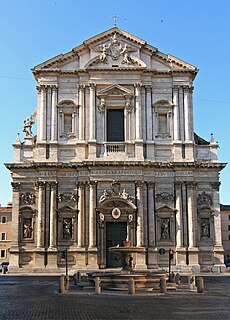
Sant'Andrea della Valle is a minor basilica in the rione of Sant'Eustachio of the city of Rome, Italy. The basilica is the general seat for the religious order of the Theatines. It is located at Piazza Vidoni, 6 at the intersection of Corso Vittorio Emanuele and Corso Rinascimento.

Santa Maria in Vallicella, also called Chiesa Nuova, is a church in Rome, Italy, which today faces onto the main thoroughfare of the Corso Vittorio Emanuele and the corner of Via della Chiesa Nuova. It is the principal church of the Oratorians, a religious congregation of secular priests, founded by St Philip Neri in 1561 at a time in the 16th century when the Counter Reformation saw the emergence of a number of new religious organisations such as the Society of Jesus (Jesuits), the Theatines and the Barnabites.
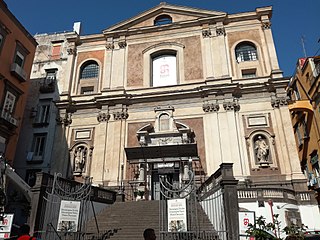
Santa Maria Donnregina Nuova is a church in central Naples, Italy. It is called Nuova ("new") to distinguish it from the older Angevin church of Santa Maria Donna Regina Vecchia.

The Tempio della Beata Vergine della Ghiara, also known as Basilica della Madonna della Ghiara, is a church in Reggio Emilia, northern Italy. The building is the property of the comune (municipality) of the city.

Padua Cathedral, or Basilica Cathedral of Saint Mary of the Assumption, is a Roman Catholic minor basilica and the cathedral located on the east end of Piazza Duomo, adjacent to the Bishop's palace, in Padua, region of Veneto, Italy. The cathedral, dedicated to the Assumption of the Virgin Mary, is the seat of the bishop of Padua. The church building, first erected as seat of a bishop of the diocese in the 4th century, has undergone major reconstructions over the centuries.

San Francesco della Vigna is a Roman Catholic church in the Sestiere of Castello in Venice, northern Italy.

The Church of San Marco in San Girolamo is a baroque parish church in Vicenza, northern Italy, built in the 18th century by the Discalced Carmelites. It houses various artworks by artists of the early 18th century from Veneto. The sacristy preserves its original furniture of the same period.
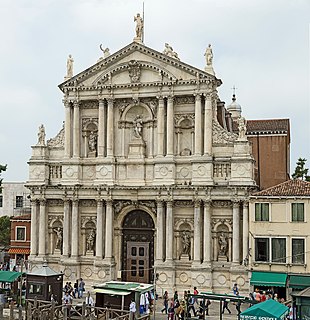
Santa Maria di Nazareth is a Roman Catholic Carmelite church in Venice, northern Italy. It is also called Church of the Scalzi being the seat in the city of the Discalced Carmelites religious order. Located in the sestiere of Cannaregio, near Venezia Santa Lucia railway station, it was built in the mid-17th century to the designs of Baldassarre Longhena and completed in the last decades of that century.

San Giovanni Evangelista is a church in Parma, northern Italy, part of a complex also including a Benedictine convent and grocery.

The Abbey of Santa Giustina is a 10th-century Benedictine abbey complex located in front of the Prato della Valle in central Padua, region of Veneto, Italy. Adjacent to the former monastery is the basilica church of Santa Giustina, initially built in the 6th century, but whose present form derives from a 17th-century reconstruction.

San Francesco d'Assisi is a Baroque style, Roman Catholic church located on via San Francesco d'Assisi in Turin, region of Piedmont, Italy. The church of San Rocco is on the same street.

San Giorgio is a Roman Catholic church located on the Piazza of the same name, just outside Porta Bruciata, in Brescia, region of Lombardy, Italy.
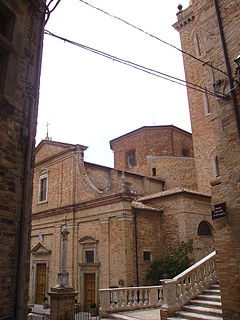
Ripatransone Cathedral is a Roman Catholic cathedral and minor basilica in the town of Ripatransone, province of Ascoli Piceno, region of Marche, Italy. It is located on Piazza Ascanio Condivi. The cathedral is dedicated to Saint Gregory the Great and to Saint Margaret. It was formerly the episcopal seat of the Diocese of Ripatransone but is now a co-cathedral in the Diocese of San Benedetto del Tronto-Ripatransone-Montalto.

Santa Caterina d'Alessandria or Saint Catherine of Alexandria is a Roman Catholic church with a main facade on Piazza Bellini, and a lateral Western facade facing the elaborate Fontana Pretoria, in the historic quarter of Kalsa in the city of Palermo, region of Sicily, Italy. In front of the main facade, across the piazza Bellini, rise the older churches of San Cataldo and Santa Maria dell'Ammiraglio, while across Piazza Pretoria is the Theatine church of San Giuseppe and the entrance to the Quattro Canti. Refurbished over the centuries, the church retains elements and decorations from the Renaissance, Baroque, and late-Baroque (Rococo) eras. This church is distinct from the Oratorio di Santa Caterina found in the Olivella neighborhood.
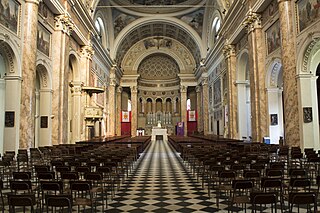
The Basilica of San Nicolò is the main place of Catholic worship in Lecco. It is situated in an elevated position and stands on the remains of the ancient city walls. It was dedicated to San Nicolò, patron saint of sailors and boatmen. The symbol of the church is the very high bell tower, which, with its 96 meters of height, represents one of the highest bell towers in Italy.
San Giovanni is a Gothic-style, Roman Catholic church located in Appignano, province of Macerata, in the region of Marche, Italy.

Macerata Cathedral is a Renaissance-style, Roman Catholic cathedral dedicated to the St Julian in the town of Macerata, province of Macerata, region of Marche, Italy.

Santa Cristina is a Baroque-style, Roman Catholic church located on via Repubblica in Parma, region of Emilia-Romagna, Italy.